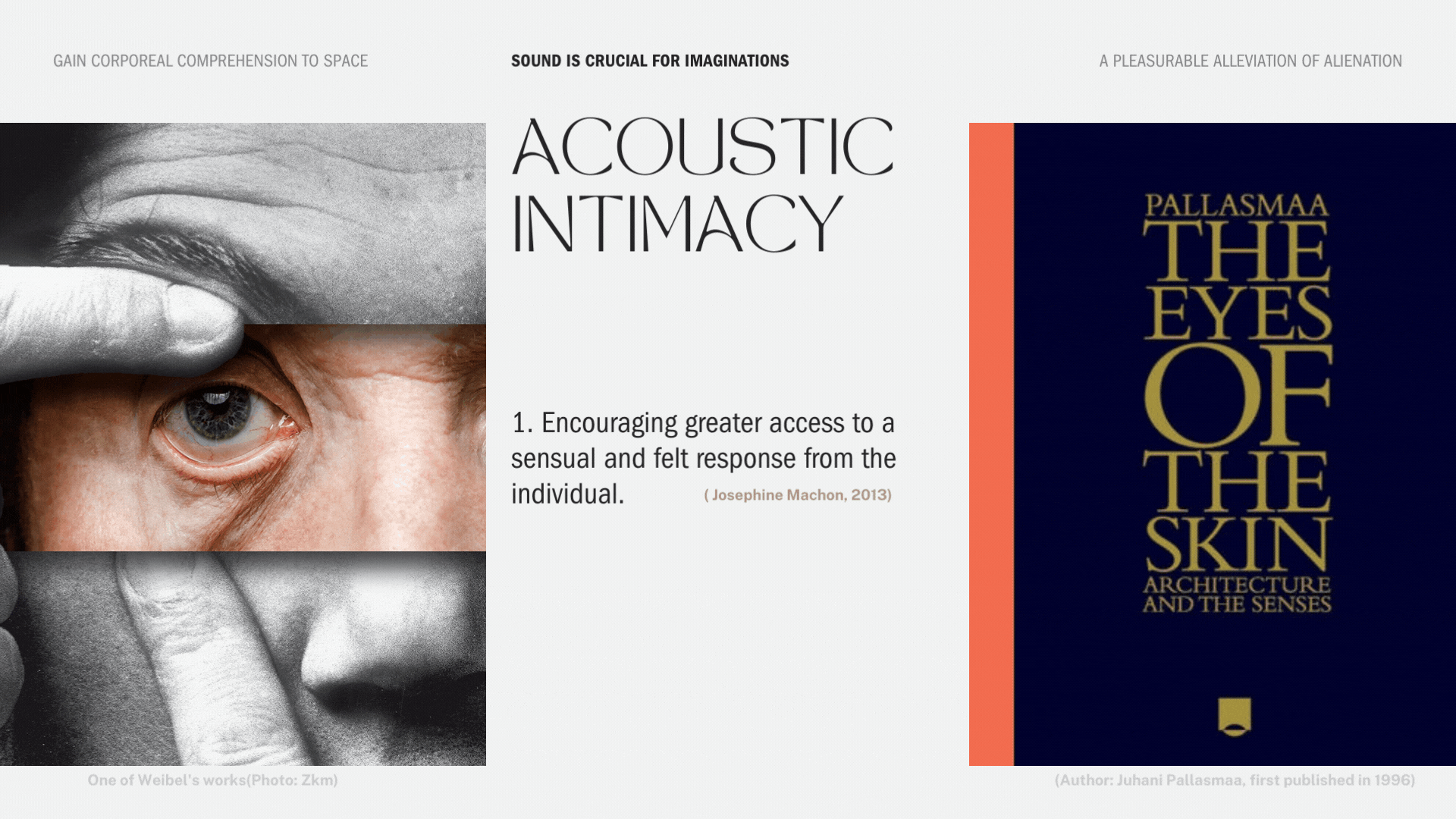
F i o n n . H a n
W r i t e r ╳ C o m p o s e r ╳ D e s i g n e r

Sonic Proxemics
╳
Immersive Theatre
The Hidden Symphony of Intimacy and Playful Politics
Research brief
Using COVID as a catalyst, this study proposes the immersive theatre approach, aiming to rebuild social closeness, raise awareness of AI applications, and rethink how we interact with others in public spaces from now on.
By integrating motion detection and biophysical sensors in smart suits as interactive triggers, this research explores new methods to enhance well-being. It focuses on the dynamic relationships between humans and non-organic entities such as robots and AI agents in mixed reality environments, allowing participants to engage through 'tele-presence'. By uncovering the invisible social connections—how individuals associate or isolate from each other—this study aims to contribute to public mental health, offering a playful and innovative approach to bringing people together.
The Abstract, Introduction and Objectives of this study are available for download here (EN+CN).
For full reference of the current study, please scroll down to the Bibliography & Credit section.


Rising Trends in Depression
Recent developments in mental health care have heightened the need for re-examining the social support system and the influence of isolation. The 2022 OECD Health Statistics indicate a twofold increase in symptoms of depression in several European countries during the pandemic, attributed in part to anti-COVID policies like mandatory social distancing and quarantine, leading to heightened social isolation, a known precursor to depression (see Figure 1) [1].
Similarly, Balakrishnan et al.’s investigation on COVID-19 depression in Asia-Pacific shows that the isolation-related risk factor (i.e., ‘living alone/isolation’ and ‘lack of social support/community support’) is the third highest, following ‘fear of COVID-19 infection’ and ‘gender’ [19]. According to OECD report, social isolation is one of the main factors resulting in the increased spread of depression and anxiety across all age groups [1].
Proximity Culture
Embracing Tele-Presence : An Underrated Layer in Public Space.
As societal dynamics shift, online meetings have become the predominant mode of communication, altering the notions of 'being there' and 'being with someone.' In response, this study seeks to reevaluate Edward T. Hall’s proxemics model within the context of post-COVID life, where digital interactions hold equal importance to in-person relationships.
Several studies investigating proxemics have been carried out on media and communication fields. However, far too little attention has been paid to ‘tele-presence’ or ‘tele-participation’, which shakes the definition of ‘space’ in the traditional sense. As highlighted by Drąg (2020), failure to consider this transformation of the role of space in communication using modern technologies can increasingly weaken the cognitive value of traditional communication models [2].
Image1: Following the advice from the South Korean government, public and private institutions introduced exams that adhere to social distancing.


Image 2: Hikari Azuma, powered by AI hologram technologies developed by Gatebox Inc., functions as a virtual home assistant dedicated to offering a comforting presence for individuals living alone.
Non-human Companions
The increasing presence of social robots, AI agents, autonomous machines.
Moreover, the integration of social robots and artificial intelligent companions into daily life, as envisioned by Bruno Latour and Donna Haraway, highlights the growing presence of non-human entities. This is supported by Novice and Rodriguez’s study (2021) which reveals that “while the real-world proxemics of human-human interaction have been well studied, the virtual-world proxemics of human-agent interaction are less well understood” [13]. Current literature includes only a few studies on 'proxemic interaction' and its visualisation, with a noticeable dearth of research on audio-related aspects.
The study by Ghaimi et al. (2022) examined the application of proxemic map in virtual reality which points toward that “using proxemics to perform new interactions in an immersive environment has not been systematically explored" [14]. In addition, study by Camara and Fox (2022) found that “robot navigation in environments with static objects is largely solved, but navigating around humans in dynamic environments remains an active research question for autonomous vehicles (AVs)” [9].
Dynamic Proxemics
Playful Politics Between Non-humans and Humans.
In other words, Hall's proxemics model has become insufficient for explaining the evolving interaction dynamics between humans and objects. “The proxemic utility needs to be given in the form of continuous functions corresponding to the continuous motion of people. A review of the literature showed that there is no available method to infer the continuous proxemic functions,” indicated Camara and Fox. Thus, this study incorporates autonomous robots and Artificial Intelligence (AI) agents into the experimental design, framing it as immersive theatre with a specific emphasis on sound. This approach aims to develop a more comprehensive understanding of proxemics, highlighting the continuous interactions among individuals in phygital spaces that mirror our mixed reality.

Image 3: Immersive Theatre〈Séance〉by Darkfield, photo by Sean Pollock.

Prototype Sketch — Four wireless Arduino devices equipped with ultrasonic sensors and powered by portable batteries. From right to left: LED 1 (red), LED 2 (green), LED 3 (yellow), and LED 4 (white).
Prototype Design
Extended bodies ╳ Elastic situations | conceptual framework
Urban scholar Ole B. Jensen builds on Edward T. Hall’s foundational work on proxemics by introducing two key concepts—extended bodies and elastic situations—to describe how we experience the relationship between our bodies and the surrounding environment. Drawing from urban studies and dermatology, his work offers a more fluid and embodied understanding of spatial dynamics. Expanding on these ideas in a post-pandemic context, this project introduces a prototype featuring participants—humans, programmed robots, and remotely operated robots—wearing interactive sensory suits.
These suits respond to physical proximity by generating sound and colorful light—the closer the participants are, the richer and more layered the sound becomes. Within this framework, the sensory suit embodies the concept of extended bodies, while the sound and lighting interactions triggered by shifting distances simulate elastic situations, translating abstract spatial dynamics into tangible, real-time sensory experiences.
Observation Reflections
Unfamiliar sensations・With(out) others | Initial experiment
The first experiment took place one evening in April 2025 at the University of Galway, involving two male PhD students as participants. Each wore a set of LED2 and LED3 wings for approximately six minutes. Both described the experience as fresh, engaging, and fun, and expressed strong curiosity to uncover the relationship between their movements and the generated sounds. Three key insights emerged from their feedback:
1. Challenging technological limits through bodily agency
2. Acoustic feedback from behind alters perception— A reflective experience
3.Pattern discovery doesn’t always require others — Potential for solo or collaborative dance exploration.
Testing LED4 wing sounds at The Long Walk in Galway’s spring. The wearer’s movements trigger sound (volume on!) and drive the motion of a coloured sphere in TouchDesigner, shown on the left screen.

Supervisors: Dr. Sam Redfern (School of Computer Science) & Dr. Máiréad Ní Chróinín (School of English and Creative Arts). Full academic reference of current study can be accessed here.
Bibliography
(selected)
[1] OECD/European Union (2022), Health at a Glance: Europe 2022: State of Health in the EU Cycle, OECD Publishing, Paris, DOI (p59).
[2] Drąg, K. (2020). Revaluation of The Proxemics Code in Mediated Communication. Social Communication, vol.1., pp93-105, DOI (p103).
[9] Camara F., Fox C. (2022) Unfreezing autonomous vehicles with game theory, proxemics, and trust. Front. Comput. Sci. 4:969194., DOI.
[13] Novick, D., Rodriguez, A.E. (2021). A Comparative Study of Conversational Proxemics for Virtual Agents. In: Chen, J.Y.C., Fragomeni, G. (eds) Virtual, Augmented and Mixed Reality. HCII 2021. Lecture Notes in Computer Science(), vol 12770. Springer, Cham. DOI.
[14] Ghaemi,Z., Engelke, U., Ens, B. & Jenny, B. (2022) Proxemic maps for immersive visualization, Cartography and Geographic Information Science, 49:3, 205-219, DOI.
[19] Balakrishnan, V., Ng, K. S., Kaur, W., Govaichelvan, K., & Lee, Z. L. (2022). Covid-19 depression and its risk factors in Asia Pacific – a systematic review and meta-analysis. Journal of Affective Disorders, 298, 47–56, DOI.
Credit
Image 1. Zastrow, M., & Park, J. M. (2020, May 12). How South Korea prevented a coronavirus disaster-and why the battle isn’t over. National Geographic. Link.
Image 2. キャラクター召喚装置「Gatebox」. Gatebox株式会社. (n.d.). Link.
Image 3. Clarke, M. (2020, March 2). Darkfield: Immersive theatre brings millennial ghost train vibe to king’s cross. Londonist. Link.
Soundtrack: Angels By My Side, by Lunar Years
Music: bensound.com
License code: RHWFATTAK9CPY2YR
